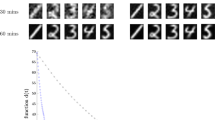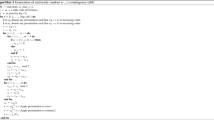Summary
In the inference of contingency table, when the cell counts are not large enough for asymptotic approximation, conditioning exact method is used and often computationally impractical for large tables. Instead, various sampling methods can be used. Based on permutation, the Monte Carlo sampling may become again impractical for large tables. For this, existing the Markov chain method is to sample a few elements of the table at each iteration and is inefficient. Here we consider a Markov chain, in which a sub-table of user specified size is updated at each iteration, and it achieves high sampling efficiency. Some theoretical properties of the chain and its applications to some commonly used tables are discussed. As an illustration, this method is applied to the exact test of the Hardy-Weinberg equilibrium in the population genetics context.
Similar content being viewed by others
References
Agresti, A. 1990,Categorical Data Analysis, John Wiley Sons.
Baglivo, J., Oliver, D. Pagano, M. 1988, ‘Methods for the Analysis of Contingency Tables with Large and Small Cell Counts’,Journal of the American statistical Association 83, 1006–1013.
Bishop, Y., Feinberg, S. Pagano, M. 1975,Discrete Multivariate Analysis, Cambridge, MA: MIT Press.
Blackman, R. Tukey, J. 1958,The Measurement of Power Spectra, New York: Dover.
Chung, K. 1960,Markov Processes with Stationary Transition Probabilities, Heidelberg: Springer-Verlag.
Cox, M. Plackett, R. 1980, ‘Small samples in contingency tables’Biometrika 67, 1–13.
Diaconis, P. Stroock, D. 1991, ‘Geometric bounds for eigenvalues of Markov chains’The Annals of Applied Probability 1, 36–61.
Fill, J. 1991, ‘Eigenvalue bounds on convergence to stationary for nonreversible Markov chains, with an application to the exclusion process’The Annals of Applied Probability 1, 62–87.
Fisher, R. 1925,Statistical Methods for Research Workers, 13th Edition, Hafner, New York.
Fisher, R. 1935,The Design of Experiments, (1st ed.), Edingurgh, London: Oliver E. Boyd, (7th edition 1960).
Gelman, A. Rubin, D. 1992, ‘Inference from iterative simulation using multiple sequences’Statistical Science 7, 457–472.
Geman, S. Geman, D. 1984, ‘Stochastic relaxation, Gibbs distributions, and the Bayesian restoration of images’IEEE transactions on Pattern Analysis and Machine Intelligence PAMI-6, 721–741.
Gewek, J. 1992, ‘Evaluating the accuracy of sampling-based approaches to calculating posterior moments’ inBayesian Statistics 4, (ed. J. M. Bernardo, J. O. Berger, A. P. Dawid and A. F. M. Smith). Clarendon Press, Oxford, UK.
Guo, S. Thompson, E. 1992, ‘Performing the exact test of Hardy-Weinberg proportion for multiple alleles’Biometrics 48, 361–372.
Hannan, E. 1957, ‘The variance of the mean of a stationary process’Journal of the Royal Statistical Society, B.19, 282–285.
Hastings, W. 1970, ‘Monte Carlo sampling methods using Markov chains and their applications’Biometrika 57, 97–109.
Heidelberger, P. Welch, P. 1983, ‘Simulation run length control in the presence of an initial transient’Operations Research 31, 1109–1144.
Hernandez, J. Weir, B. 1989, ‘A disequilibrium coefficient approach to Hardy-Weinberg testing’Biometrics 45, 53–70.
Jowett, G. 1955, ‘The comparison of means of sets of observations from sections of independent stochastic series’Journal of the Royal Statistical Society, B.17, 208–227.
Kolassa, J. Tanner, M. 1994, ‘Approximate conditional inference in exponential families via the Gibbs sampler’Journal of the American Statistical association 89, 697–702.
Lange, K. 1997,Mathematical and Statistical Methods for Genetic Analysis, Springer.
Levine, H. 1970, ‘On a matching problem arising in genetics’Annals of Mathematical Statistics 20, 91–94.
Liu, J., Wong, W. Kong, A. 1995, ‘Covariance structure and convergence rate of the Gibbs sampler with various scans’Journal of the Royal Statistical Society, B.57, 157–169.
Louis, E. Dempster, E. 1987, ‘An exact test for Hardy-Weinberg and multiple alleles’Biometrics 43, 805–811.
Mehta, C. Patel, N. 1983, ‘A network algorithm for performing Fisher’s exact test in r × c contingency tables’Journal of the American Statistical Association 78, 427–434.
Metropolis, N., Rosenbluth, A., Rosenbluth, M., Teller, A. Teller, E. 1953, ‘Equations of state calculations by fast computing machines’Journal of Chemical Physics 21, 1087–1092.
Pagano, M. Halvorsen, K. 1981, ‘An algorithm for finding the exact significance levels for r × c contingency tables’Journal of the American Statistical Association 76, 931–934.
Patefield, W. 1981, ‘An efficient method of generating randomr × c tables with given row and column totals (Algorithm AS 159)’Applied Statistics 30, 91–97.
Raftery, A. Leiws, S. 1992, ‘How many iterations in the Gibbs sampler?’ inBayesian Statistics 4, (ed. J. M. Bernardo, J. O. Berger, A. P. Dawid and A. F. M. Smith), 763–774. Clarendon Press, Oxford, UK.
Skovgaard, I. 1987, ‘Saddlepoint expansions for conditional distributions’Journal of Applied Probability 24, 875–887.
Stout, W. 1974,Almost Sure Convergence, Academic Press.
Acknowledgements
We thank the editor and the two referees whose comments/suggestions improved the quality of the paper.
Author information
Authors and Affiliations
Appendix: Proof of the Theorem
Appendix: Proof of the Theorem
-
(i)
Irreducibility: We need to show that ∀T, T′ ∈ Γ0, T′ can be obtained from T through finite number of transitions and P(T′|T ) > 0 (Hastings, 1970). Let (i1, i2, j1, j2) be the basic move which decrease 1 count at the positions (i1, j1) and (i2, j2) each, and increase 1 count at the positions (i1, j2) and (i2, j1) each. Apparently, any of the basic moves keeps the boundary condition unchanged. In case of row plus column constraint with sub-table requirement (b), and other cases with sub-table requirement (a), T′ can be obtained by finite number \( S=\frac{1}{4}\sum_{ij}|T_{ij}^{'}-T_{ij}| \) of basic moves ei’s from T, each basic move involves four count changes in four positions in T, which can be covered by a sub-table Di with dimension no less than two (in the row plus column constraint case, can be covered by at most two sub-tables with dimension no less than three), since P(Di) > 0 and P(ei|Di) > 0, and the transition from T to T′ can possibly be achieved through some other ways, so
$$ P(T^{'}|T)\geq\prod_{i=1}^SP(D_i)P(e_i|D_i)>0. $$Reversibility: For any T and T′ ∈ Г0, by the proof above, there are finite number of intermediate states T1,..., Tm−1, and sub-tables D1,..., Dm, such that T, the Ti’s and T′ are only differ on a sub-table Di, and T′ is obtained by successive transition from T via T1, ..., Tm, let T0 = T and Tm= T′. It is easy to check that \( P(T_{i-1})P(T_i|B_{D_i})=P(T_i)P(T_{i-1}|B_{D_i}), \) by the definition of the transition probability, so we have
$$ P(T)P(T^{'}|T)=P(T)\prod_{i=1}^mP(D_i)P(T_i|T_{i-1})=\prod_{i=1}^mP(D_i)P(T_{i-1})P(T_i|B_{D_i})\\=\prod_{i=1}^mP(D_i)P(T_{i-1})P(T_i|B_{D_i})=P(T^{'})\prod_{i=1}^mP(D_i)P(T_i|T_{i-1}|B_{D_i})=P(T^{'})P(T|T^{'}). $$The reversibility ensures P(·) is the invariant distribution of the chain, the irreducibility ensures P(·) is the unique equilibrium distribution of the chain, and the state space of the chain is finite, thus (6) and (7) are direct results in Chung (1960, p.99).
-
(ii)
Liu, et al (1995) proved the results for Gibbs sampler, the same method applies here, and the required conditions (a), (b) and (c) in Liu, et al (1995) are satisfied by this sampler since the state space is finite and the chain is irreducible. Then define the forward operator and follow steps similarly there.
-
(iii)
since P(·) is an (initial) stationary distribution of the chain, EP|g(T)l < ∞ and irreducibility of the chain is the same as Markov ergodic, Theorem 3.6.7 in Stout (1974) gives the result.
Rights and permissions
About this article
Cite this article
Yuan, A., Yang, Y. A markov chain sampler for contingency table exact inference. Computational Statistics 20, 63–80 (2005). https://doi.org/10.1007/BF02736123
Published:
Issue Date:
DOI: https://doi.org/10.1007/BF02736123




